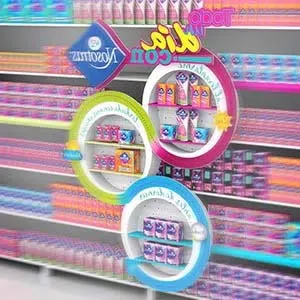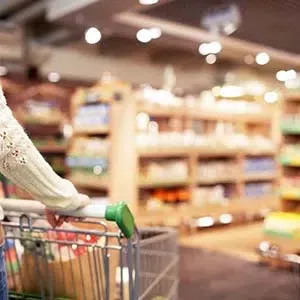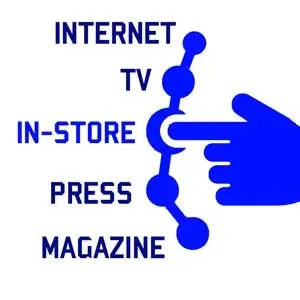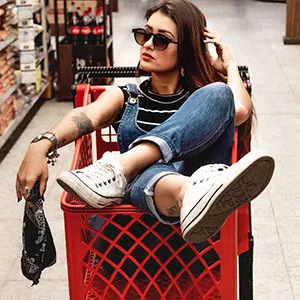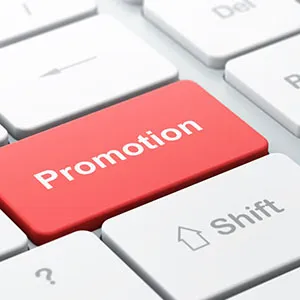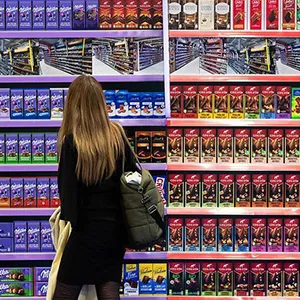Product activations in retail
The role of point-of-purchase
in the product marketing mix
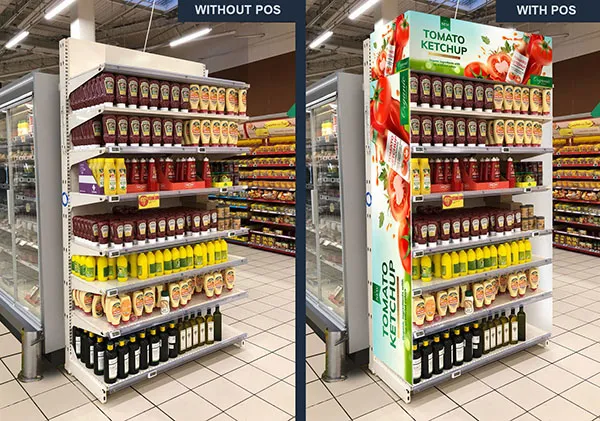
Most marketers are convinced that commercials on television or radio, in newspapers, on the internet or social media are our main motivation to look for a new product in a store. They are effective indeed on those of us (not many) that are already convinced of the quality of a product.
However, most of us who buy a new product for the first time in a store, did not look for it on purpose. First, we see it on the shelves and only then we remember its advertising. Consciously or unconsciously, we make a connection, and we may decide to try the product. All out-of-store marketing levers work as a catalyst of a random event: I see it and then I recognize it.
The promotion mix is part of the marketing mix. It refers to the integration of communication initiatives used by marketers to create awareness and eventually persuade consumers to make a purchase.
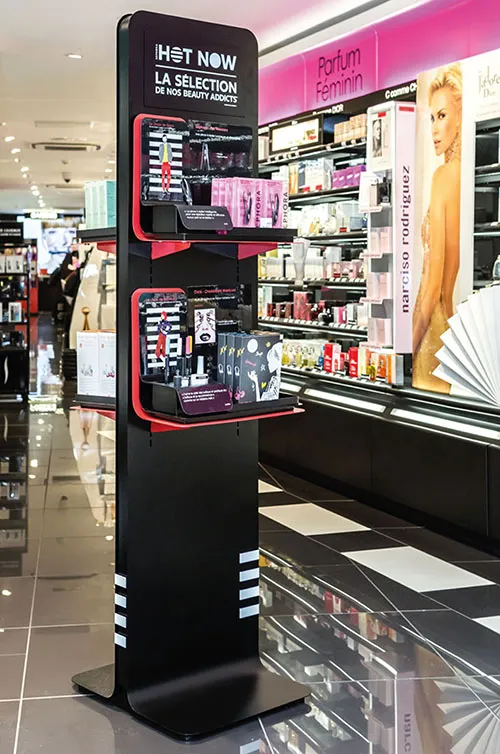
Pilotes specializes in the design of commercial furniture, display and merchandising solutions. We offer 100% customized point-of-purchase materials tailored to the in-store projects of brand and retail. Because we care about the climate and environment, we analyze the lifecycle of each project to avoid, reduce, and offset its impact 🌍🌿
Do you have a project planned? Contact us and let’s bring your vision to life together!
Out of sight, out of mind
The best way to stimulate sales in stores is to make the product extra-visible among similar merchandise to visitors who rush through their shopping trip. This is the key strength of any point of purchase (POP) initiative. It closes the circuit of the promotion mix in the middle of the critical phase of consumer orientation, the last meter of our shopping journey.
If marketers have invested in commercials to mark their product introduction and they disconsider how visible the new product is in stores, they run the risk of having a much lower result than expected. And if sales are ultimately deceiving, they blame it on various reasons without thinking that the cause is likely an instore visibility problem. Eye-tracking studies show that more than 50% of shoppers who did not buy a new product, simply haven’t noticed it.
"According to our shopper behaviour study using eye-tracking in the impulse-sensitive biscuits department of an Italian supermarket, 100 participants see on average not more than 28 of the 193 articles offered. A customer visits the department for an average of 70 seconds and sees an average of 15% of the offer", Carlo Oldrini, Vice President Marketing at Ipsos
Marketing at the point of purchase develops the fundamental capacity of a product to attract our attention within a store context, whether it’s on shelves, on counters or on the shop floor. It directs our focus on the product, creates a link with its advertising and eventually closes our shopping journey.
CASE: Function of Beauty

Customized hair-care brand Function of Beauty is the 1st beauty brand made for you (and only you). You decide what goes into your formula (and what doesn't) and what you get out of it. A one-of-a-kind experience!
Early 2020, Function of Beauty launched a TV campaign across 20 networks. Inviting people to visit the FunctionofBeauty.com website, the main objective was clearly sales. Late 2021, the brand expands to general merchandise retailing with four base formula options. Based on preferences and desired end result, customers can choose out of 10 booster packets,
To translate its experience to the shop floor, the 4-year-old startup kicks of a POP-campaign, among other with an end cap and an on-shelf unit. Both display materials orient us through a unique and interactive shopping experience. They take advantage of our need for cohesion, a principle reinforced by psychology which states that we respond well to brands that have regularity in their presentations.

CASE: Gillette’s Planet KIND
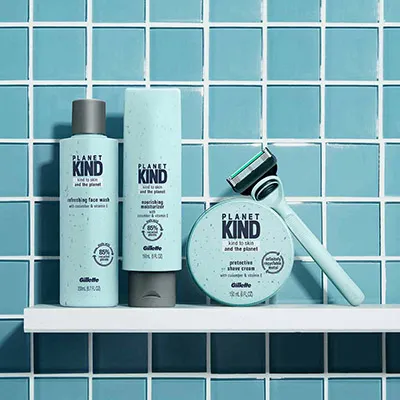
In February 2021, Procter & Gamble's Gillette launches Planet KIND, a new brand that is kind to skin and planet. With its commitment to reduce waste, this green line makes it easier for eco-responsible consumers to incorporate eco-friendly choices.
A marketing collateral supports the brand introduction: a graphical visual experience, pack shots, photos, videos and the website planetkindbygillette.com to buy a subscription.
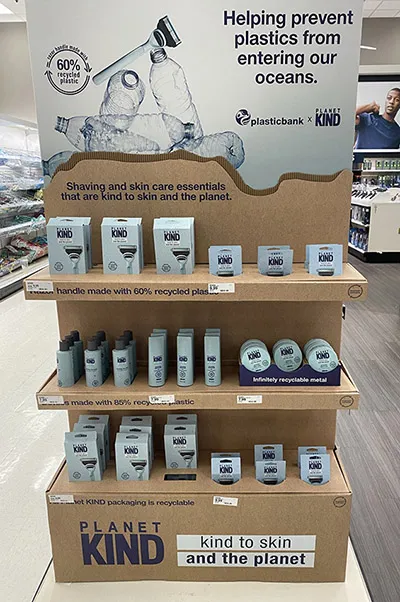 To
mark its debut in groceries stores, Gillette develops this hefty and strategic end cap. Everything lives
and breathes an eco-friendly lifestyle. It creates an event on the busy fast track of stores by carefully
merchandising the complete line as magnets for shopper eyes.
To
mark its debut in groceries stores, Gillette develops this hefty and strategic end cap. Everything lives
and breathes an eco-friendly lifestyle. It creates an event on the busy fast track of stores by carefully
merchandising the complete line as magnets for shopper eyes.
The vectors of instore visibility
Because all POP initiatives are 100%-customizable, there are numerous possibilities to increase visibility. The only limitation is probably relevance and the imagination of your POP producer.
Examples of differentiating levers include:
- Product placement and merchandising, the physical organization of allocated spaces. They allow shoppers to find and reach out to what they want faster. Products sells products! Nothing beats getting to see, touch, smell or try a product to scrutinize. The focus of the shopping eyes is always on the physical product.
- Messaging, language and graphical codes - short, simple, direct, readable in just a few seconds, easy to digest for the shopping brain.
- Imagery - clear, coherent and recognizable for your target audience.
- Colors are the soul of any POP initiative. They appear faster on the shopper radar or they help to recognize the products.
- Tangible creativity - your chance to express your creative force with eye-rubbing shapes or designs.
- Materials can make a POP material look dynamic. They can deliver a desired visual experience or bring a touch of authenticity. Or they convey quality, value, emotions and meaning. Bright lighting makes POP material even more attractive.
- Adaptation to context - the right material in the right place. Your material will prettify your warehouse if store owners don’t find it relevant, nor adapted to its context, retail format, category and location. This practical reality is undeniable.
- Exceptional experiences don't happen by accident; brands have to create them and implement them on shop floors down to the tiniest detail. Everything has to be super-user friendly.
- Technology can integrate the most relevant benefits of an online experience with the physical buying journey.
- Execution and instore operations transforms vision and a cool idea from theory to reality.
Key takeaways
Anyone who’s worked on a product introduction or an activation knows that commercial success in-store can get the job done. A slick promotional campaign is paramount, but nothing compares to the thrill of connecting with a product in real life.
But if shoppers do not notice the product in a pre-attentive phase, it is impossible for them to focus their attention and scrutinize the offer on quality, features, benefits, taste, use, price, etc. Investing in in-store experiences that engage shoppers effectively help your product to reach new customers and to survive the critical phase of its launch
Because of their diversity, marketers coordinate the levers of in-store visibility carefully with brand and product. To ensure that we will see consistency, they have a common thread. This is essential to activate the relevant structures that the promotion mix nested in our minds, rather than leaving us confused to the point of inertia in front of contradiction.
Date: April 2021 — bh
Do you wish to stimulate sales for your brand with instore visibility? Reach out today to set up a free consultation. We'll find the best solution for your brand.
